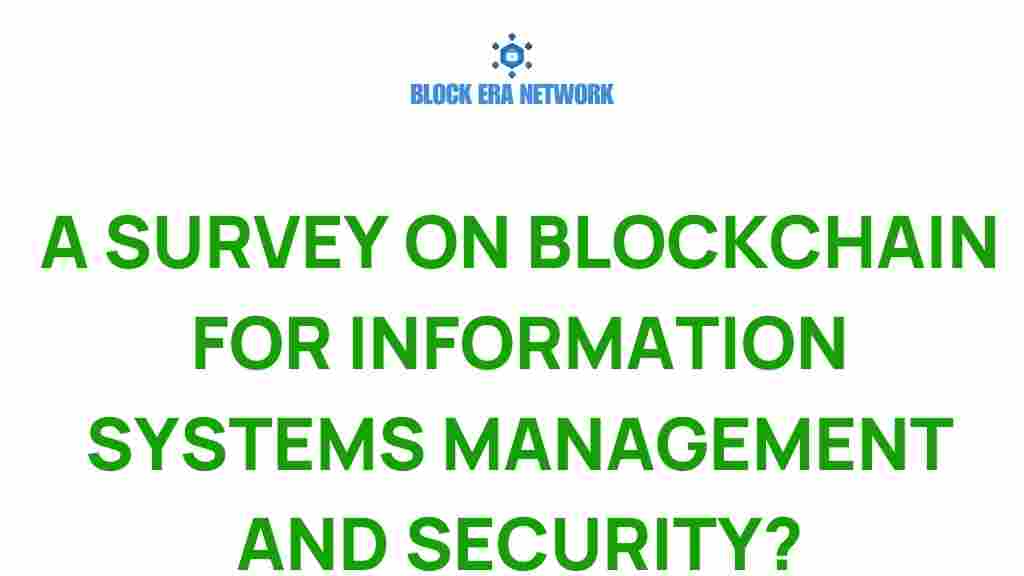Unlocking Blockchain: A Deep Dive into Information Systems Security
In today’s digital landscape, the importance of information systems security cannot be overstated. With the rapid evolution of technology trends, organizations are increasingly turning to blockchain as a solution to enhance their security management practices. This article explores how blockchain technology can secure data integrity, bolster cybersecurity, and support digital transformation while effectively managing risks.
Understanding Blockchain and Its Role in Information Systems Security
Blockchain is a decentralized ledger technology that records transactions across multiple computers in such a way that the registered transactions cannot be altered retroactively. This feature makes blockchain a strong candidate for enhancing security management in various information systems.
The Core Features of Blockchain Technology
- Decentralization: Unlike traditional databases controlled by a central authority, blockchain distributes data across a network of nodes, reducing the risk of data breaches.
- Immutability: Once a transaction is recorded on the blockchain, it cannot be modified or deleted. This ensures data integrity and transparency.
- Consensus Mechanisms: Blockchain employs consensus algorithms to validate transactions, ensuring that all parties agree on the state of the ledger.
- Cryptography: Secure cryptographic techniques are used to encrypt data, enhancing cybersecurity and protecting sensitive information.
How Blockchain Enhances Security Management
Implementing blockchain in information systems significantly improves security management through various means:
1. Ensuring Data Integrity
Data integrity is a critical aspect of information systems security. Blockchain’s immutability ensures that once data is entered, it remains unchanged. Here’s how it works:
- Every transaction is time-stamped and linked to the previous transaction, creating a chain.
- Altering any data would require consensus from the entire network, making unauthorized changes nearly impossible.
2. Strengthening Cybersecurity
With cyber threats on the rise, organizations need robust defenses. Blockchain enhances cybersecurity by:
- Providing a secure environment for storing sensitive data, reducing vulnerability to hacks.
- Enabling secure peer-to-peer transactions without the need for intermediaries.
3. Supporting Digital Transformation
The digital transformation journey involves integrating advanced technologies to improve business processes. Blockchain supports this by:
- Facilitating seamless data sharing across various platforms.
- Enabling automation through smart contracts, which execute actions automatically when conditions are met.
Step-by-Step Process to Implement Blockchain in Your Information System
Integrating blockchain into your existing information systems requires a structured approach. Here’s a step-by-step guide:
Step 1: Assess Your Needs
Identify the specific areas within your organization that require enhanced security or improved data integrity. Consider factors such as:
- Current vulnerabilities in your systems.
- Data types that require protection.
- Compliance requirements relevant to your industry.
Step 2: Choose the Right Blockchain Platform
There are various blockchain platforms available, each with unique features. Choose one that aligns with your security management needs, such as:
- Ethereum: Known for smart contracts and decentralized applications.
- Hyperledger: A suite of open-source tools for enterprise-level blockchain solutions.
Step 3: Develop a Pilot Project
Start with a small-scale pilot project to evaluate the effectiveness of blockchain in your information systems. This allows you to test:
- The integration process.
- The performance of the blockchain solution.
- User acceptance and training requirements.
Step 4: Implement Full-Scale Integration
Once the pilot project is successful, plan for full-scale integration. This includes:
- Training staff on the new system.
- Establishing governance frameworks for blockchain management.
Troubleshooting Common Issues in Blockchain Implementation
Implementing blockchain is not without challenges. Here are some common issues and tips to address them:
1. Scalability Concerns
As more transactions occur, blockchains can become congested. To mitigate this:
- Consider using layer 2 solutions like Lightning Network for Bitcoin.
- Optimize your blockchain’s consensus mechanism for faster transaction processing.
2. Integration with Legacy Systems
Integrating blockchain with existing legacy systems can be challenging. Solutions include:
- Using APIs to facilitate communication between systems.
- Gradually phasing out legacy systems as blockchain capabilities mature.
3. Regulatory Compliance
Ensure that your blockchain implementation complies with relevant laws and regulations. This can be achieved by:
- Staying informed about local and international regulations regarding blockchain technology.
- Consulting with legal experts during the planning phase.
Conclusion: The Future of Information Systems Security with Blockchain
The integration of blockchain into information systems security represents a transformative shift in how organizations manage security management, data integrity, and risk management. As technology trends evolve, embracing this innovative approach will not only bolster cybersecurity efforts but also pave the way for successful digital transformation.
As we look to the future, organizations that leverage blockchain technology will be better positioned to safeguard their data, enhance operational efficiency, and gain a competitive edge in an increasingly digital world. For further reading on this topic, check out this in-depth study on blockchain and cybersecurity.
By understanding the intricacies of blockchain and its application in information systems, businesses can unlock new opportunities for growth while effectively managing risks in their digital landscape.
This article is in the category Crypto Security and created by Block Era Network Team
